A guest project by Rich Faulhaber, contributing Evil Mad Scientist.
“Walking the beach with the kids, one of our favorite pastimes is collecting shells, bits of sea glass and other rocks. We typically put them in buckets, sort them when we get home, and then put them in the garden– except for the few special ones that the kids keep on their dresser.
In the process of making a garden path which stretches 50 feet long and is 2.5 feet wide, I thought, how cool would that look if it were some sort of mosaic of sea glass! Snapping back to reality I realized how much time would be required to collect that much sea glass and got discouraged. But (eureka!) you can make your own. All you need is some glass, some sand, sea water and some way of mimicking the ocean and (bam!) you get sea glass.
I wanted to do large volumes, so I borrowed my uncle’s cement mixer to mimic the ocean. The steel fins inside mimic large rocks. I started breaking wine bottles into small pieces and stole some sand from the kids play box, adding it all to the mixer. Since I didn’t have any sea water handy I just filled it with tap water and turned it on. After an hour I checked and the sharp edges were all broken off, after two hours there was some frosting and smoothing and after 4 hours et voilà— I had sea glass! With the capacity of the mixer I will have my garden path in no time. I plan on experimenting with other media and time duration and will report on my progress in the future.”
An ordinary hardware store cement mixer, tap water, and play sand. Simpler and more environmentally friendly than using many other common abrasives that are used with rock tumblers.
Add glass and allow to run for several hours. After running, drain the excess the sand-water slurry through a coarse screen.
After dumping out the excess and some of the glass.
This batch was made with a mixture of broken green and brown glass, mostly from wine jugs, and allowed to run for four hours. Below are some pictures of glass allowed to run for different lengths of time.
Here’s what the raw glass looks like, zero hours in the mixer.
These pieces were pulled out after one hour in the mixer. Their sharp edges are broken, and there’s light etching of the surfaces.
These pieces were pulled out after two hours in the mixer. The shapes are slightly more rounded, and the surfaces are beginning to frost heavily.
And after four hours, the pieces begin to look a lot like what you might find washed up on a sandy beach. While it will be interesting to see how the pieces change over longer pieces of time, you probably don’t want to go too much longer (and wear them too much thinner) if you’re making mosaic pieces for people to walk on.




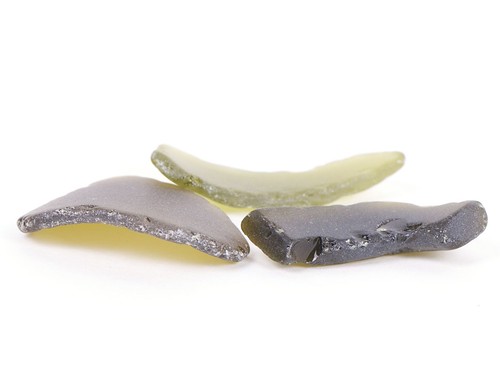
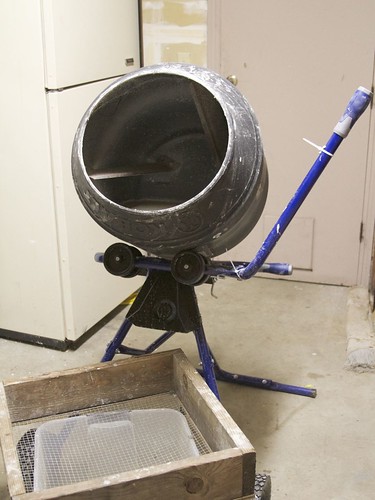
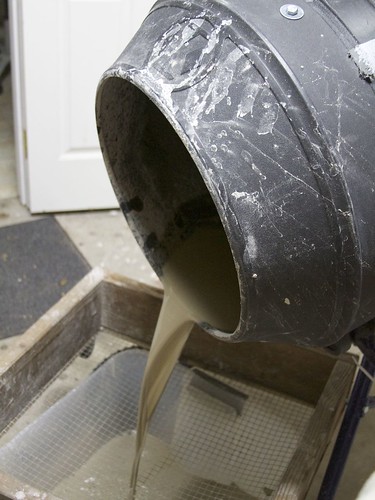
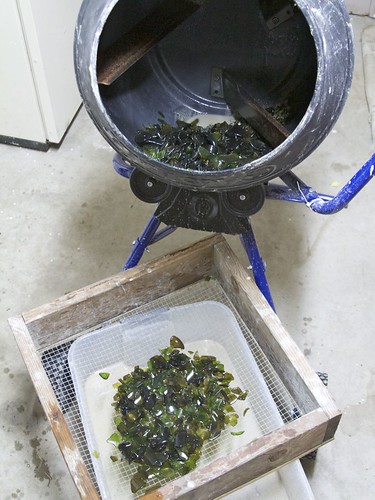

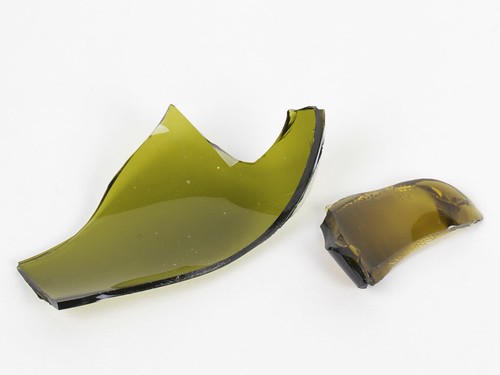
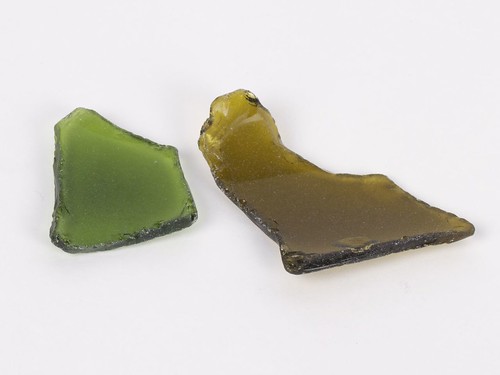
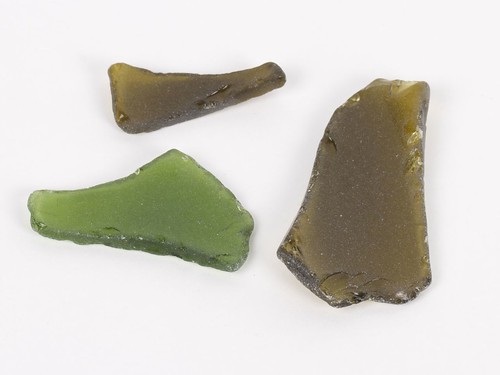
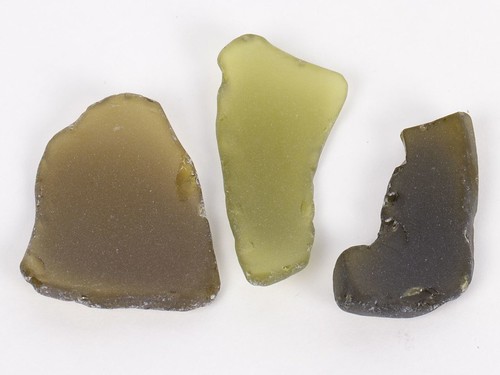
I have not collected a lot of beach glass in my life, but what I have collected (mostly at Ft. Bragg on the CA coast) has been rounder and thicker than these pieces. I know that Ft. Bragg’s glass is the result of early residents dumping their trash into the ocean. Maybe antique jars and bottles were made of thicker glass than wine and beer bottles are today? Are there any commonly available sources of thicker, colored glass?
champagne bottles are thicker, as are many of the snap top lemonade glass bottles. I agree id look for thicker glass. older coke bottles were pretty thick too.
With the new year passing, I have obtained a large number of thicker bottles, they are next in the Q.
If the curvature isn’t important to you, you could also consider contacting a local stained glass shop to see what they do with their scrap. Personally, I’m lucky in that I’m within a couple hours’ drive of an art glass manufacturer, from whom I can buy scrap (odd shapes, 4-6" diameter) for a dollar a pound. They remelt their cullet, but I know some other companies sell cullet in bulk to glass artists and others.
Nice but won’t it develop new sharp edges as people walk on it and pieces break?
Um, what part of EVIL Mad Scientist was unclear? ;)
Seriously though, as long as the pieces are anchored to something supportive (e.g. embedded in concrete) it’ll probably be okay. Glass can shatter from impacts but is surprisingly durable against simple compressive force, and a person’s weight will be spread out among a large number of pieces.
If it freezes where you live, be aware that glass and concrete expand and contract at different rates with temperature change, and the glass will crack. As long as it doesn’t come loose from the concrete (un-imbedded?) it should be OK.
People who make stepping stones with stained glass are warned to bring the stones indoors in the winter, but that’s not practical, of course, for a concrete walkway.
Interesting. I wonder if using sand-sized charcoal as some portion of the aggregate would allow you to make up for the CTE mismatch.
That’s assuming glass has a lower CTE: if the CTE is greater, maybe some steel chips from a local machine shop.
Glass is a common aggregate in concrete, though generally not in structural uses. It generally creates a lighter concrete. I don’t think there is any difference in the CTE between glass and concrete. From what I have read, the main problems are with the alkali-silica reaction and contamination. Wash the glass well, use low-silica cement, and make sure you use air entrainment additives and you should have long lasting non-structural concrete.
I’ve used recycled glass aggregate (actually created from recycled glass in a hardened foam) for a lighter than water concrete canoe, and it worked excellent. This looks like a cool project, and I hope it turns out well.
I have some stepping stones with stained glass scraps on concrete. The pieces are various shapes and sizes, some 6 inches long. They are in grout on pre-made concrete stones. They have been outside for over 10 years and nothing has cracked or come off.
Embedding glass in concrete is not a good idea. Glass reacts in the highly alkaline environment of concrete and creases an expansive gel-you’ll crack the concrete and pop the pieces loose.
On a small island in the gulf of Thailand, Koh Tao, there is a hotel/bungalows for rent/restaurant called OK view, and they have their steps (it is on a side of a mountain, so, lots of steps) lined with bottles, bottom up. Kerry who runs the place says they have been there over ten years, and almost none of them have broken down. And these are whole bottles with only one side embedded in concrete. So, I’d say (judging from Kerry’s steps) that it will work wonderfully! Agreeing, I am.
Maybe you could start from sand, or melt down the glass bottles and re-cast them into thicker disks.
Cool! Is the slurry you filtered out full of jaggy glass shards? Or are they also broken down into sand like particles?
Just wonder if there is a disposal problem with the slurry.
The slurry isn’t jagged or anything, but I was concerned on just dumping it in the yard as I have chickens and Ducks free ranging all day. My solution is to use the slurry as an additive in my concrete projects. Works quite well.
Rock Tumblers are pretty cheap from harborfreight.com, and I think they’re $40. Try using different grits on the glass, you could get those edges really smooth and nice.
For some weirdness, treat your broken glass to some muriatic acid, though I’m not sure what kind of bucket to put it into. Check with the hardware store. The acid will eat the flat pieces of glass and create a pitted texture.
For even more weirdness, draw or write on the bottle with a fine sharpie, then break up the bottle, and treat it to an acid bath. The sharpie should resist the acid, and the acid should not etch the glass where the sharpie ink is. Then finish with the rock tumbler.
Who can help me inkjet-print onto a glass bottle?
It’d be easier to make a reverse print on an old photocopier or laser printer that uses plasticky toner, then do an acetone transfer. Scuff up the glass first, maybe.
Neat idea, thanks! I’ve done acetone transfers to copper before patinating. I’ve done frosting and back painting on glass. I never thought to transfer to glass.
Muriatic acid will also eat the cement, so it’s best to wash it off very well before laying.
I tried bleaching my driveway with muriatic acid once…….once! Lets just say the green gas was a total turn off to the idea.
I did concrete work for a few years on someone else’s crew; forming, steelwork, pouring and finishing. Acid washing exposed aggregate is the most interesting process, seeing the coloured rock appear from grey cream in green smoke!
Harbor Freight has terrible customer service and they do not back up their rock tumblers… I have 3 of them. The belts break constantly!!
the belts are to tight. lossen the pulles so they are just tight enought to turn the barrels.
Muriatic acid (hydrochloric acid) shouldn’t eat glass at all, unless it’s very unusual glass (sugar glass maybe). Concentrated sulfuric, nitric and hydrochloric acids are all stored in glass containers without degradation for years. Alkali can eat glass over time and can corrode ground glass stoppers permanently into bottles.
I have no experience with concrete and acids, however. Sounds spectacular.
I know that DIY is pretty much the point of this project, but for those who would like large quantities of beach glass and don’t have access to a cement mixer (or the patience), you can actually buy tumbled glass in bunk from various suppliers (such as from http://www.vitrohue.com/tumbled.html).
Or, you can buy the real deal from me, http://www.tropicalseaglass.com. I find my sea glass on beaches in Hawaii. I’ve been collectinf for a long time and I can ALWAYS spot the fake stuff. But, if you have a large project you can’t expect to use all jewelry quality glass although I have some customers who have done just that!
Not everyone lives near a beach, and many beaches with good sea glass are <i>protected by law</i> so that you can’t collect there. I don’t see any use in referring to this as "fake" — it’s real glass, tumbled in sand. Manmade, yes, but so is the glass.
Windell H. Oskay
drwho(at)evilmadscientist.com
http://www.evilmadscientist.com/
I’ve been photographing broken shards of antique Tiffany glass for the past three years in a project called Empire of Glass. The glass was rescued from being dumped into the East River during the Great Depression by my grandfather, and I can confirm that much like in this project, its "weathered" look formed over the years makes it just a magical material to work with. Louis Comfort Tiffany, arguably the greatest glassmaker of all time, understood that it was actually the impurities and not the perfection of the glass that made it great, and a lot of his glass was based on aquatic themes and imagery, so it seems that water and glass are indeed a proper match.
Regards,
John D’Agostino
http://www.EmpireofGlass.com
wow amazing mate..! you had such a cool idea. I loved the variuos photo at different time they stayed in the cement mixer.. We were using the same metod to clean the mixer when i was working in building..just that insted glass we were using rock in order to take off all the cement. Cool keep showing us you mad experiment !!
I can’t be the only one who saw that title and hoped you were making this: http://xkcd.com/260/
You were not the only one. Me too:)
That was good thinking on your part to mass produce glass that mimicks sea glass to finish your project. I’ve got one for you Mr. Evil Mad Scientist. Have you heard of " Hydration"? This is the process that occurs whilst glass is tumbling to and fro in the sea in order to achieve it’s frosted appearance. The process occurs over decades. If you would like to know more because after all your are a scientist check out my site – http://www.mermaidspurseseaglass.com ..a lesson in sea glass. Happy Experimenting!
Fair Winds and Calm Seas,
Deborah Leon
http://www.mermaidspurseseaglass.com
I have not really ever found any seaglass, but have thought about making some myself with a rock tumbler. However, my tumbler barrel is rubber. I like the idea of the cement mixer better. And I know I could buy some glass, either manmade or found, but I think it would be more fun to make it myself.
Of course, if I made it myself (or even if I purchased ocean-tumbled sea glass), I would disclose any of these facts for jewelry making purposes. I know there are a lot of purists when it comes to sea glass and I would call myself one. There is nothing wrong with making it one’s self as long as it is disclosed if those items are to be sold.
Diane, Rock Wear Gems
I’d like to find out how much sand is required for the process if a standard size mixer is used and filled to capacity (2/3 full) with broken glass.
Cheater cheater pumpkin eater!
Do you think this would make an interesting mulch?
Hi
I noticed the date is quite old on this topic so appologies for dragging it up again, however I am trying to make a large quantity of beach glass for my garden and have followed your instructions and the results are no-where as good as yours. I have done it for 9 hours in 3 hour sessions yet mine are not even as good as your 1 hour photo.
Could you be kind enough to tell me the ratio of glass/sand/water as closely as you can please?
Much appreciated
What a great idea! My daughter and I have been kicking around the idea of making a mosaic topped table for years and we both loved your method of making your own glass pieces. I have a collection of wine bottles and old jars that I found in my Father-in-law’s garage and we now have a use for them. Does the glass have to be close to the same thickness?
Thanks.
We live in a small town and have a small town dump no longer in use. I have found many old broken glass containers in sapphire blues and even light purple. It is just all over the ground already broken in the right sizes. You might check into this if you have one near by. Now, I just need a cement mixer, what a fantastic idea! Thanks so much for your information.